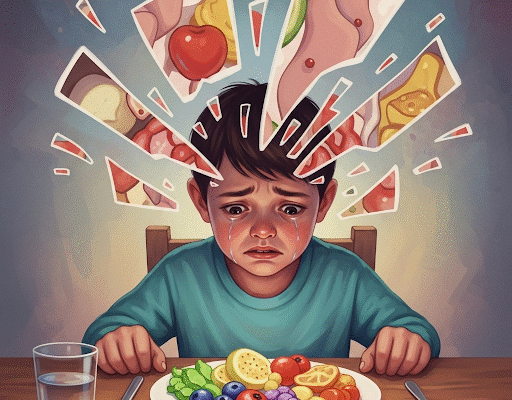Food is more than just fuel. It’s a custom. It’s a link. It’s the fragrance of something warm in the kitchen when you get home from school, the sound of people laughing over birthday cake, or the taste of your favourite dish on a bad day. Food is a big part of our families, cultures, and festivities.
But for some kids and teens, food means something else entirely. It turns becomes a source of worry, fear, or control. It doesn’t bring people together; it makes them feel alone. Instead of feeding people, it turns into a battleground that many parents and carers don’t even know is happening until it’s too late.
More and more young people are having trouble with their relationship with food in today’s fast-paced world full with images. Kids find it tougher to just eat when they’re hungry and stop when they’re full because of social media, diet culture, and the pressure to appear a specific way. Instead, they are monitoring calories, skipping meals, and fretting that eating dessert would make them “bad.”
We see these problems every day at Cincinnati Children’s, and we want families to know they aren’t alone.
A Quiet Fight That Happens Too Often
For a lot of young people, their eating problems don’t start with anything big. It could start with a decision to “eat healthier” or “cut back a little.” Someone your age or even an adult might say something like, “Are you really going to eat all that?” or “You’re getting so tall; you must be eating a lot!” A simple moment can occasionally turn into a seed of worry or shame.
From then, things can get out of hand very rapidly. A teenager who used to love food learns to worry about nutrition labels. A kid who used to love family meals suddenly starts making excuses to miss them. A high school athlete starts working out alone at night, even after a two-hour practice.
Even while these actions don’t always scream “eating disorder,” they are often symptoms. They show that something isn’t quite right, and that’s when assistance is most important.
Our Way: Healing the Body and Mind
We help adolescents, teens, and young adults (ages 8 to 25) who have eating disorders at Cincinnati Children’s. This encompasses both documented eating disorders including anorexia nervosa, bulimia, and binge eating disorder, as well as unhealthy habits that haven’t been identified but are still hurting you.
The one thing all of these young people have in common is that they have a hard, unpleasant relationship with eating. We need to assist people get back to being healthy and balanced, not just in their bodies but also in their minds and emotions.
The people who take care of you are:
Doctors who check on people’s physical health and deal with any problems that come up.
Mental health specialists who look at how food affects people’s thoughts, feelings, and actions.
Registered dietitians who assist people get back to eating properly and trusting food again.
This team-based approach makes sure that we’re not simply treating the symptoms; we’re also helping each child understand why they’re having trouble and how they might start to get better.
What Makes People Eat Wrong?
There isn’t just one thing that causes disordered eating. For some youngsters, it all starts with a diet. For some people, a huge shift in their life, like moving, breaking up, losing someone, or even going to high school or college, can set it off.
When things get stressful, the need to feel in control can sometimes turn into a preoccupation on food or body image. In certain circumstances, disordered eating is caused by a deeper problem, such anxiety, depression, trauma, or low self-esteem. Kids who are naturally perfectionists or very hard on themselves may feel pressure to “get it right,” which can lead to unhealthy eating habits.
Social media just makes things worse. Videos and manipulated bodies of “what I eat in a day” and posts from influencers can gently (or not-so-subtly) perpetuate unrealistic standards. These platforms can help people learn about eating disorders, but they can also make bad behaviours seem typical. That’s why it’s so vital for adults to be involved and know what’s going on.
What to Look For: Signs of Trouble Ahead
People don’t always expect how disordered eating looks. Kids don’t have to be really underweight or miss every meal to be having a hard time. The indicators can be hard to see at times. Sometimes, it’s simple to ignore them—until it’s not.
Here are four important things to keep an eye on:
1. Changes in How You Eat
Taking away whole dietary groups, such dairy or carbs, without a medical reason.
food a lot less than normal or becoming obsessed with “clean” food.
Worrying too much about how many calories, macronutrients, or portions you eat.
Not eating meals without a good reason, even when you can see you’re hungry.
Not eating meals you used to like or not eating in public.
2. Exercise That Seems Compulsive: Making yourself work out even when you’re sick, hurt, or tired.
Getting obviously unhappy if they don’t work out or do something active.
Choosing to work out instead of going to school or social gatherings.
Working out on the sly in addition to planned practices or gym time.
Using exercise to deal with or get away from feelings.
3. Changes in Mood and Social Behaviour: Talking badly about their physique, weight, or looks.
Avoiding friends, especially when eating or going out with them.
Not going to family dinners or other functions where you have to eat.
Showing symptoms of being anxious, angry, or sad.
Getting lower grades or losing interest in things you used to enjoy.
4. Bathroom and hygiene habits
Taking a long time in the toilet after meals.
Going to the toilet right after eating a lot of the time.
Signs of throwing up or misusing laxatives (albeit they aren’t always easy to see).
When to Get Involved
It’s essential to get treatment if any of these indicators are getting in the way of your child’s everyday life: they’re skipping meals, becoming socially isolated, continuously criticising themselves, or eating is a cause of terror.
Remember that a lot of kids will declare they’re “fine” even when they’re not. They might ignore what you say or say they’re “just trying to be healthy.” If teachers, coaches, friends, or family members are worried about you, listen to them.
Also, keep in mind that certain kids are more at risk than others. Children who have anxiety, despair, perfectionism, or obsessive thoughts are more likely to develop unhealthy eating patterns. If your child fits this description, pay more attention to how they eat and how they feel about their physique.
What Teachers and Coaches Do
Teachers, school nurses, and coaches can help find the first indicators of disordered eating. But they can also make the problem worse, even if they don’t mean to.
Students who are already vulnerable may have detrimental thoughts when they learn about calorie monitoring, BMI, or severe food guidelines in health class. Even if they intend well, comments regarding weight might hurt more than help.
Schools should focus on body positivity, healthy diet, and mental health instead of thinness or doing well at any costs.
What Recovery Really Looks Like
Getting better doesn’t just mean gaining weight or ending a certain behaviour. It’s about helping kids learn to trust their bodies, food, and themselves again. It implies realising that they are more than just their looks or what they eat. It’s about learning to love themselves and accepting life as it is, with all its flaws and messiness.
For some kids, getting better doesn’t take long. It could take months or even years for some people. What matters is that the people around them are consistent, kind, and helpful.
How to Help
You don’t have to know everything as a parent, carer, or teacher. But you can make a place where youngsters can talk safely. You can listen without making a decision. And you can gently push them to get help.
Here’s how to get started:
Talk about food in a good, nonjudgmental way as often as you can.
Show your kids how to eat in a balanced way and respect their bodies.
Don’t call foods “good” or “bad.” You can eat any meal and yet be healthy.
Don’t say anything about your child’s weight, shape, or how much they eat. Don’t pay attention to how they seem; pay attention to how they feel.
Don’t be critical; be curious. “I’ve seen that you’ve been missing meals a lot lately.” Do you want to talk about it?
If your child is already getting help, you may help them by being patient, learning about the process, and being involved. Ask how you can help. Go to family therapy sessions. Be the person they can trust.
Help early saves lives
One of the worst things about eating disorders is that some kids suffer in quiet for a long time. But getting help early can change everything. A child’s prospects of a full and lasting recovery are enhanced the sooner they obtain care. And sure, it is extremely feasible to get better.
Don’t delay if you’re worried about a kid or teen. Get in touch. Speak with a mental health professional, your child’s doctor, or a school counsellor. At Cincinnati Children’s, we’re here to help families every step of the way with expert treatment, kindness, and hope.
Because every child should have a connection with food that is safe, happy, and free.



